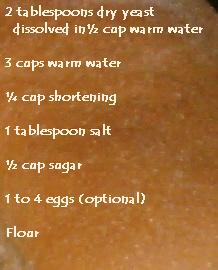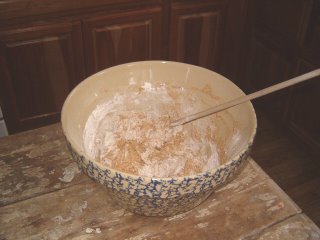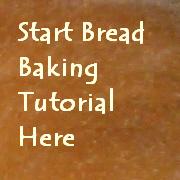I bake bread for my family every week. Home baking is not that hard, not that time consuming, and certainly cheap! You don't need a bread machine or a lot of fancy equipment. This blog features a tutorial on home bread baking, tips on equipment and ingredients, and recipes for real home cooking.

The number of eggs is quite variable. I often use no eggs. Sometimes I cut back to 2 cups of water and use as much as six eggs. This makes a dough that is like bagel dough or sweet bread dough if you add a little more sugar.
I use a long handled wooden spoon for mixing and for measuring the shortening, which doesn’t need to be measured precisely. A ¼ cup size dollop from the mixing spoon is fine.

The directive to “200 times without reversing direction. Let sit 20 minutes.” might be the most mysterious part of the recipe. During this time the flour is absorbing water and forming long strands of protein called gluten. Later we will want this gluten since it will stretch and contain the bubbles of carbon dioxide produced by the yeast. More bubbles mean lighter bread. Stirring back and forth would break up the strands of yeast. (At least that is what I was taught but as I write these words they look like a theory begging to be proved or disproved.)
Letting the dough sit for 20 minutes gives the flour time to thoroughly absorb the liquid and makes it harder to add too much flour in the final phase of the recipe. This is easily observed; after the rest the batter looks thicker and gloppier.

After letting the dough rest, you continue to add flour, sprinkling it on a little at a time and mixing. It soon starts to look less like a blob and more like a ball; this is your cue to switch from a mixing motion to kneading.
When my kids were little they loved to help with making bread. I let them measure the ingredients and help me count to 200 as we stirred. When I put the dough up to rest before kneading I would often wait quite a long time to add the rest of the flour and then knead the dough, as the kids were only in the way during the kneading process. I would “sneak” a little kneading here and there while they were diverted with other things, but the bread didn’t suffer. They were invited back after the dough rose and they would happily shape dough into two half-size loaf pans.
Next: Kneading
Previous posts
Archives
ATOM 0.3
Looking for more?
There's more to food than just nutrition, otherwise we would all be eating custom-formulated kibble. I didn't exactly learn to bake from my grandmother, but my ancestors, even the ones I never met, have informed and influenced my lifelong exploration of cooking and food. Want to read more? Check out this entry from my home blog, French Road Connections


0 Responses to “Mixing Bread”
Leave a Reply